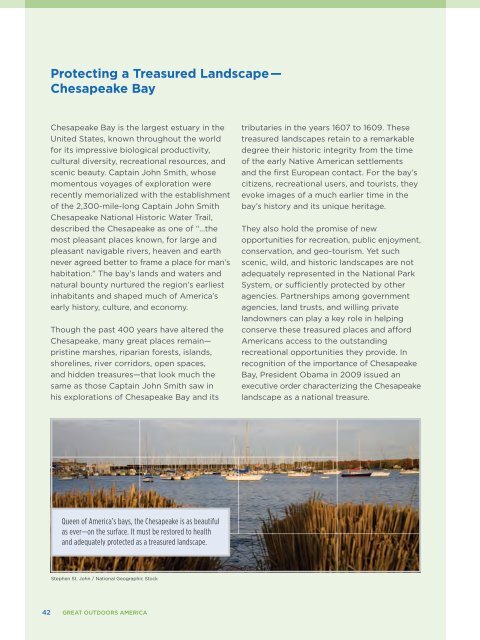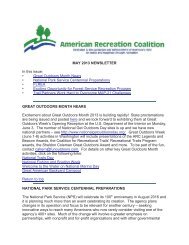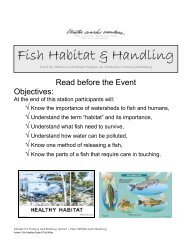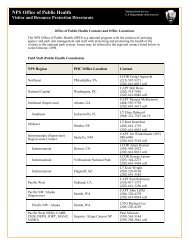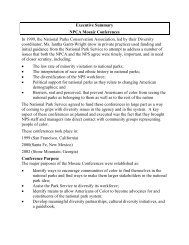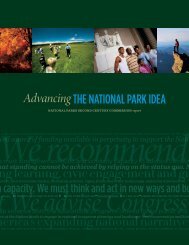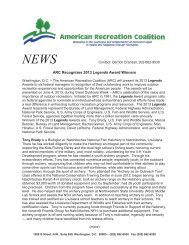Outdoor Resources Review Group Report - American Recreation ...
Outdoor Resources Review Group Report - American Recreation ...
Outdoor Resources Review Group Report - American Recreation ...
Create successful ePaper yourself
Turn your PDF publications into a flip-book with our unique Google optimized e-Paper software.
Protecting a Treasured Landscape—<br />
Chesapeake Bay<br />
Chesapeake Bay is the largest estuary in the<br />
United States, known throughout the world<br />
for its impressive biological productivity,<br />
cultural diversity, recreational resources, and<br />
scenic beauty. Captain John Smith, whose<br />
momentous voyages of exploration were<br />
recently memorialized with the establishment<br />
of the 2,300-mile-long Captain John Smith<br />
Chesapeake National Historic Water Trail,<br />
described the Chesapeake as one of “…the<br />
most pleasant places known, for large and<br />
pleasant navigable rivers, heaven and earth<br />
never agreed better to frame a place for man’s<br />
habitation.” The bay’s lands and waters and<br />
natural bounty nurtured the region’s earliest<br />
inhabitants and shaped much of America’s<br />
early history, culture, and economy.<br />
Though the past 400 years have altered the<br />
Chesapeake, many great places remain—<br />
pristine marshes, riparian forests, islands,<br />
shorelines, river corridors, open spaces,<br />
and hidden treasures—that look much the<br />
same as those Captain John Smith saw in<br />
his explorations of Chesapeake Bay and its<br />
Queen of America’s bays, the Chesapeake is as beautiful<br />
as ever—on the surface. It must be restored to health<br />
and adequately protected as a treasured landscape.<br />
Stephen St. John / National Geographic Stock<br />
42 GREAT OUTDOORS AMERICA<br />
tributaries in the years 1607 to 1609. These<br />
treasured landscapes retain to a remarkable<br />
degree their historic integrity from the time<br />
of the early Native <strong>American</strong> settlements<br />
and the first European contact. For the bay’s<br />
citizens, recreational users, and tourists, they<br />
evoke images of a much earlier time in the<br />
bay’s history and its unique heritage.<br />
They also hold the promise of new<br />
opportunities for recreation, public enjoyment,<br />
conservation, and geo-tourism. Yet such<br />
scenic, wild, and historic landscapes are not<br />
adequately represented in the National Park<br />
System, or sufficiently protected by other<br />
agencies. Partnerships among government<br />
agencies, land trusts, and willing private<br />
landowners can play a key role in helping<br />
conserve these treasured places and afford<br />
<strong>American</strong>s access to the outstanding<br />
recreational opportunities they provide. In<br />
recognition of the importance of Chesapeake<br />
Bay, President Obama in 2009 issued an<br />
executive order characterizing the Chesapeake<br />
landscape as a national treasure.


